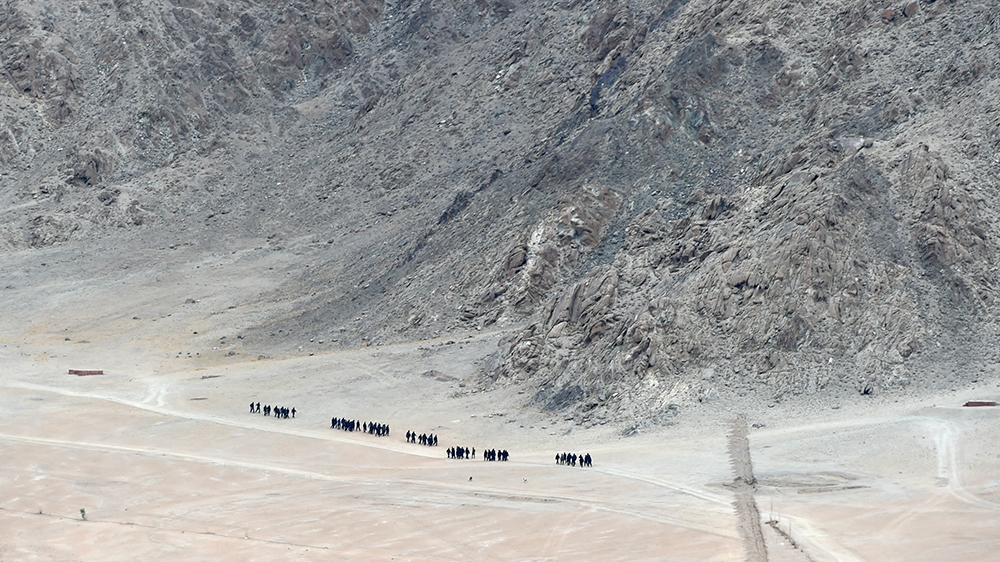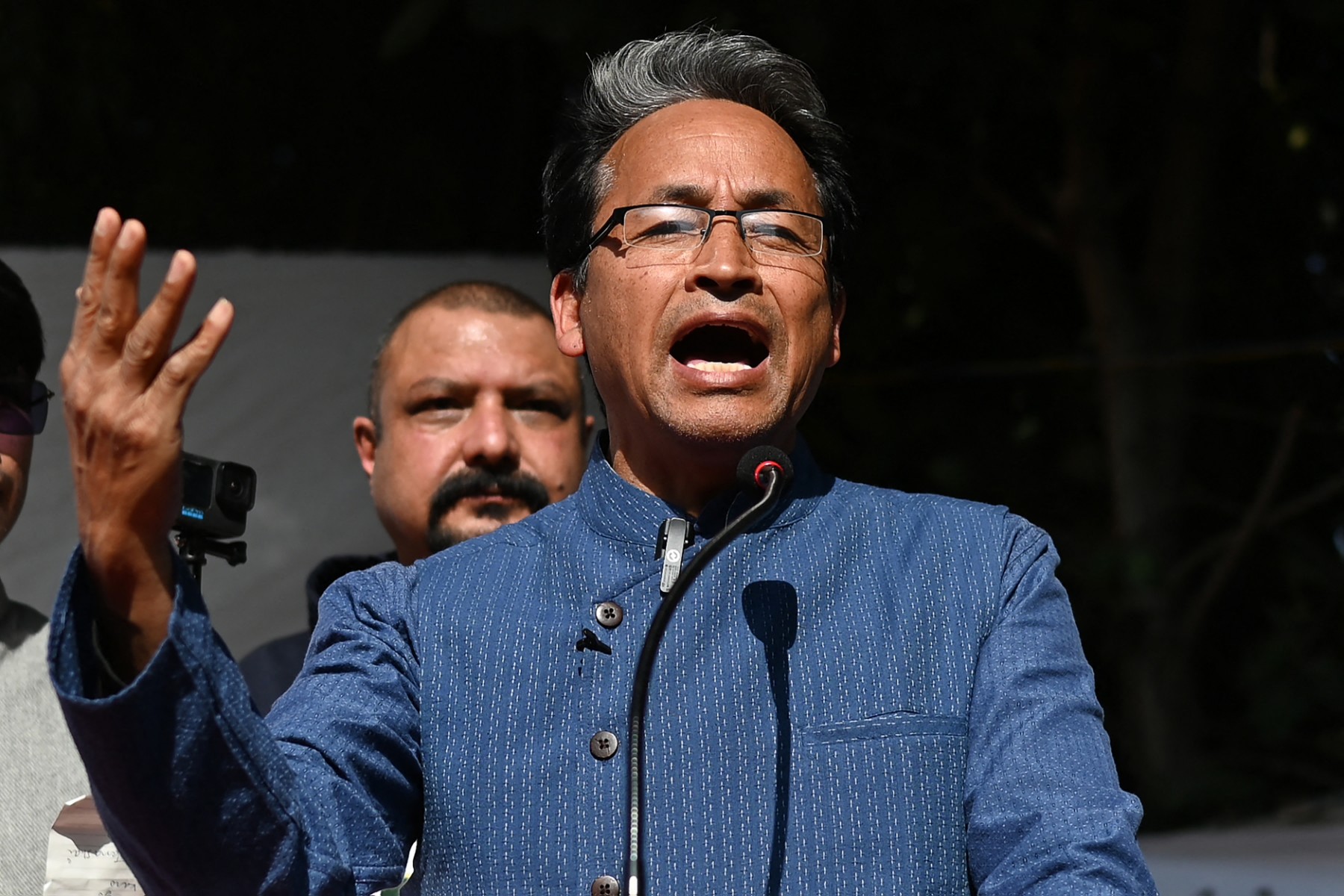
More than four years ago, when India’s Hindu nationalist government carved out Ladakh from Indian-administered Kashmir, the regional capital, Leh, erupted in joy. A majority of its voters even cast ballots for Prime Minister Narendra Modi’s party for fulfilling a long-term demand. They had accused the Kashmir-based leadership of discriminating against the Buddhist-majority Himalayan region, known for its snowcapped peaks and lush grasslands.
But the jubilation in Leh did not last long.
The government’s decision to run the territory directly from New Delhi has raised concerns about the region’s democratic marginalisation, lack of say in developmental projects and militarisation of the ecologically sensitive Himalayan region, located at an altitude of 5,730 metres (18,800ft).
On March 6, hundreds of people assembled in Leh after the latest round of talks with the interior ministry yielded no results. Ladakh activist Sonam Wangchuk launched a 21-day fast unto death to demand a devolution of power and constitutional protections to fight against what he said is an onslaught of outside influence that threatens the loss of their tribal identity.
“I want to follow the peaceful methods …so that our government and policymakers take notice of our pain and act,” Wangchuk said.
Who is behind the latest protest? What are its demands?
In August 2019, Modi’s Bharatiya Janata Party (BJP) government scrapped the special status granted to Kashmir and bifurcated it into two federally administered regions – Jammu and Kashmir as well as Ladakh.
But Ladakh’s leaders said they have lost political representation in the current bureaucratic setup and have little say in the development projects announced by the New Delhi-run administration. New laws passed by the federal administration that allows outsiders to settle and start businesses in the region has also alarmed locals.
Two autonomous bodies formed in the mid-1990s and early 2000s for self-governance in Leh and Kargil have now been stripped of much of their powers. The local bodies known as the Ladakh Autonomous Hill Development Councils had a key role in decisions related to healthcare, land and other local issues in the Leh and Kargil districts.

People have been taking to the streets to protest. Activist Wangchuk held a five-day fast in January last year by camping in subzero temperatures, highlighting the threat posed to the pristine environment by planned mining and industrial projects.
On February 3, thousands of residents gathered in Leh, the main city in Ladakh, under the leadership of the Leh Apex Body and Kargil Democratic Alliance, which represent the aspirations of Buddhist-majority Leh and Muslim-majority Kargil.
They are demanding statehood for Ladakh, a tribal status under the Sixth Schedule of the Indian Constitution, which allows the formation of autonomous administrative divisions with some legislative, judicial and administrative autonomy within a state. They make laws on important things like land, forests, water and mining – crucial for a region in which 97 percent of the population is tribal.
“It’s very crucial for us being tribal and sparsely populated to stand for our rights,” Lhador Rapper, a student based in Leh who sings protest rap songs, told Al Jazeera.
“We celebrated in 2019, thinking we had long waited for this moment, but it was of no use.”
A Hindi-language song posted by Rapper on YouTube has been watched 69,000 times. It is called Sixth Schedule for Ladakh, and here is a translation of some of its lyrics:
Listen to the voice of Ladakh, my countrymen. How’s this government when one cannot even speak? We aren’t just blabbering. Our home is at risk.
Representatives of the two districts have held multiple protests and meetings with New Delhi to demand rights for the Indigenous people on land and jobs.
Nine rounds of talks between New Delhi and leaders from Ladakh have ended in deadlock. The last meeting held on March 4 yielded no concrete results.
“We want the restoration of democracy in the region,” Wangchuk, an educator and a prominent voice in the current protests, told Al Jazeera.
For a long time, the majority Buddhist population in Leh had resented the centre of power in the region being based in Srinagar, the Kashmiri capital 420km (260 miles) away. When India revoked Kashmir’s semi-autonomy and divided the region, Wangchuk said he expected a legislature for Ladakh to have a hand in decision-making. But that did not happen. Its government is led by a lieutenant governor, who is appointed by India’s president. Under the current arrangement, Ladakh’s people feel more underrepresented than ever.
Before the removal of Kashmir’s semi-autonomy, outsiders were prevented from buying land and settling in the region. But now there is growing apprehension in Ladakh about a potential demographic shift and damage to the fragile ecosystem. Kashmiris have also expressed similar concerns.
The extension of the Sixth Schedule of the Indian Constitution to Ladakh, its residents said, would safeguard them from demographic changes and resource exploitation by outsiders.
Even local BJP leaders are backing the demands.
“We stand with the people, and we are also demanding safeguards under the constitution,” Nawang Samstan, a BJP leader from Leh, told Al Jazeera.

What are the environmental concerns facing Ladakh?
Ladakh is known for its glaciers and glacial lakes, which are a major source of water for the region. The Himalayan glaciers along with the river basins they feed are called the “water tower of Asia”. They are among the few frozen freshwater resources in the world.
However, the climate change-induced retreat of glaciers and changing weather patterns have made the region water-stressed, which residents said threatens their future. They said increasing numbers of tourists have also put pressure on its limited resources.
In the peak season in summer, tourists outnumber the 274,000 locals. In 2022, 450,000 tourists visited Ladakh in the first eight months of the year. The government’s plans to boost tourism and exploit the region’s natural resources have alarmed residents.
According to reports, seven hydropower projects have been proposed, and several industrial groups have shown interest in exploring the region rich in minerals such as borax, gold, granite, limestone and marble.
Bids have also been solicited for solar projects while the Ladakh government has sought permission to clear 157 hectares (388 acres) of forest land for building electricity transmission lines.
“The developmental projects will bring some convenience to people, but no one is interested in this kind of development,” Wangchuk said.
“What is the use of development without democracy?” he asked, adding that Ladakh would become a playground for industrialists who are interested only in profits.

“They are not interested in the future or local people.”
In the past three years, India has built military infrastructure. such as roads and bridges and acquired land for military purposes amid tensions with China caused by a territorial dispute. Locals who have lost land said they feel vulnerable.
“We cannot say it openly, but we would want the military to be as sustainable as possible,” said a Leh-based activist who spoke to Al Jazeera on the condition of anonymity.
The 35-year-old said the concerns of locals are being ignored.
Why have people from Kargil joined the protests?
Kargil, about 200km (125 mile) west of Leh, wanted to be part of Muslim-majority Kashmir when the region was divided and has accused the government in Leh of political and financial discrimination.
However, over the past three years, the political landscape of the region has undergone a tectonic shift. Leh and Kargil have joined forces in a move many Ladakhi analysts consider unprecedented.
Overcoming religious and political divides, leaders from both districts are now uniting for “a greater cause”, which Wangchuk described as “a fight for Ladakhi identity”.
Sajad Kargili, a member of the Kargil Democratic Alliance, told Al Jazeera that people from Leh and Kargil are on one page now.
“Our fear related to our identity, our jobs, our demography is real, and everyone in the region realised it,” he told Al Jazeera.
“There is not only demographic change but the bigger fear that our ecologically will be ruined.”







